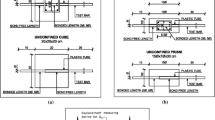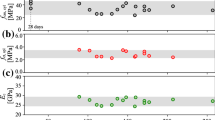Abstract
The dynamic behavior of the bond slip between a deformed reinforcing bar and plain concrete has been experimentally investigated by employing Hopkinson bar techniques. Pullout tests with various specimen types (unconfined, confined, cast-in-place, post-installed etc.) have been performed. Pullout of the steel rebar and splitting of the concrete cylinder have been the failure modes induced. Test results comprise peak pullout forces and complete bond stress–slip diagrams. They clearly show that the dynamic pullout forces and curves are well above the static ones, and that the pullout work of bond failure is considerably greater for the dynamic impact loading. Confinement, provided by a steel tube, leads to improved bonding; peak loads increase up to 2.5 times. The effects of bond length and concrete strength have also been put into evidence. Finally it has been verified that post-installed rebars, depending upon the particular adhesive employed, can achieve the same bond resistance as the cast-in-place ones.














Similar content being viewed by others
References
Tepfers R (1973) A theory of bond applied to overlapped tensile reinforcement splices of deformed bars. Publication 73:2 Thesis, Division of Concrete Structures, Chalmers University of Technology, Göteborg, p 328
Gambarova PG, Rosati GP (1997) Bond and splitting in bar pullout: behavioural laws and concrete cover role. Mag Concr Res 49(179):99–110
Walker PR, Batayneh MK, Regan PE (1997) Bond strength tests on deformed reinforcement in normal weight concrete. Mater Struct 30:424–429
Viawathanatepa S, Popov EP, Bertero VV (1979) Effects of generalized loadings on bond of reinforcing bars embedded in confined concrete blocks. Report UCB/EERC-79/22, University of California, Berkeley
Tassios TP (1979) Properties of bond between concrete and steel under load cycles idealizing seismic actions. Comité Euro-International du Béton; Bulletin No. 131, Paris
Eligehausen R, Popov EP, Bertero VV (1983) Local bond stress–slip relationships of deformed bars under generalized excitations. Report UCB/EERC-83/23, University of California, Berkeley
Lowes LN (1999) Finite element modeling of reinforced concrete beam-column bridge connections. PhD Dissertation, Department of Civil Engineering, University of California, Berkeley, p 416
Vos IE, Reinhardt HW (1982) Influence of loading rate on bond behavior of reinforcing steel and prestressing strands. Materiaux et Constructions 15(85):3–10
Yan C (1992) Bond between reinforcing bars and concrete under impact loading. PhD Thesis, Department of Civil Engineering, University of British Columbia, p 369
Weathersby JH (2003) Investigation of bond slip between concrete and steel reinforcement under dynamic loading conditions. PhD Dissertation, Department of Civil and Environmental Engineering, Louisiana State University, p 263
Solomos G, Berra M (2006) Testing of anchorages in concrete under dynamic tensile loading. Mater Struct 39(7):695–706
RILEM (1970) Technical recommendations for the testing and use of construction materials: RC 6, bond test for reinforcement steel. 2. Pull-out test.
Lundgren K (2000) Pull-out tests of steel-encased specimens subjected to reversed cyclic loading. Mater Struct 33(231):450–456
CEN (2001) Testing hardened concrete—Part 1: shape, dimensions and other requirements for specimens and moulds, European Standard EN 12390-1
Solomos G, Berra M (2005) Compressive behaviour of plain concrete at higher strain rates. J Mech Behav Mater 16(1–2):113–121
Lindholm US (1971) High strain rate tests. In: Bunsmah RF (ed) Techniques of metals research, vol V, Part l. Wiley, New York
Malvar LJ (1992) Bond reinforcement under controlled confinement. ACI Mater J 89(6):593–601
Gambarova PG, Rosati GP, Zasso B (1989) Steel-to-concrete bond after concrete splitting: test results. Mater Struct 22(127):35–47
Kromeling HA, Zielinski AJ, Reinhardt HW (1980) Experiments on concrete under single and repeated uniaxial impact tensile loading. Report 5-80-3, Stevin Laboratory, Delft University of Technology
Bentur A, Mindess S, Banthia NP (1986) The behavior of concrete under impact loading: experimental procedures and methods of analysis. Materiaux et Constructions 19(113):371–378
Rossi P, Toutlemonde F (1996) Effect of loading rate on the tensile behavior of concrete: description of the physical mechanisms. Mater Struct 29:116–118
Cadoni E, Albertini C, Labibes K, Solomos G (2001) Behavior of plain concrete subjected to tensile loading at high strain rate In: Proceedings fracture mechanics of concrete structures, FRAMCOS-4, ENS Cachan, France, 28 May–1 June 2001, vol 1, pp 341–348.
Bischoff PH, Perry SH (1991) Compressive behavior of concrete at high strain rates. Mater Struct 24:425–450
CEN (2001) Eurocode 2: design of concrete structures—part 1: general rules and rules for buildings, prEN1992-1
Cook RA, Kunz J, Fuchs W, Konz C (1998) Behavior and design of single adhesive anchors under tensile load in uncracked concrete. ACI Struct J 95(1):9–26
EOTA (2006) Technical report, assessment of post-installed rebar connections, TR 023, European Organisation for Technical Approvals
ACI Committee 318 (2002) Building code requirements for structural concrete (ACI318-02) and commentary (318R-02). American Concrete Institute, Farmington Hills, MI
Acknowledgements
This investigation has been performed within the EU project ANCHR (BRPR-CT97-0549) “Anchorages in normal and high performance concretes subjected to medium and high strain rates”. The financial support of the European Commission is kindly acknowledged. The partners of the project consortium were: Densit a/s, Hilti, JRC, ENEL-CRIS (currently partly incorporated under CESI RICERCA), Politecnico di Milano, University of Patras and Bekaert. The authors are thankful to all of them for the fruitful interactions. ENEL-CRIS has also been partially supported by the Research Fund for the Italian Electricity System. Thanks are also extended to Professor R. Eligehausen, University of Stuttgart, for his advice to the JRC work. Finally, the authors especially wish to express their thanks to their colleagues, who have participated and contributed in carrying out the experiments at the respective laboratories.
Author information
Authors and Affiliations
Corresponding author
Rights and permissions
About this article
Cite this article
Solomos, G., Berra, M. Rebar pullout testing under dynamic Hopkinson bar induced impulsive loading. Mater Struct 43, 247–260 (2010). https://doi.org/10.1617/s11527-009-9485-z
Received:
Accepted:
Published:
Issue Date:
DOI: https://doi.org/10.1617/s11527-009-9485-z




